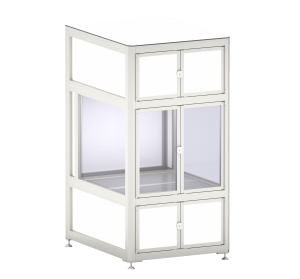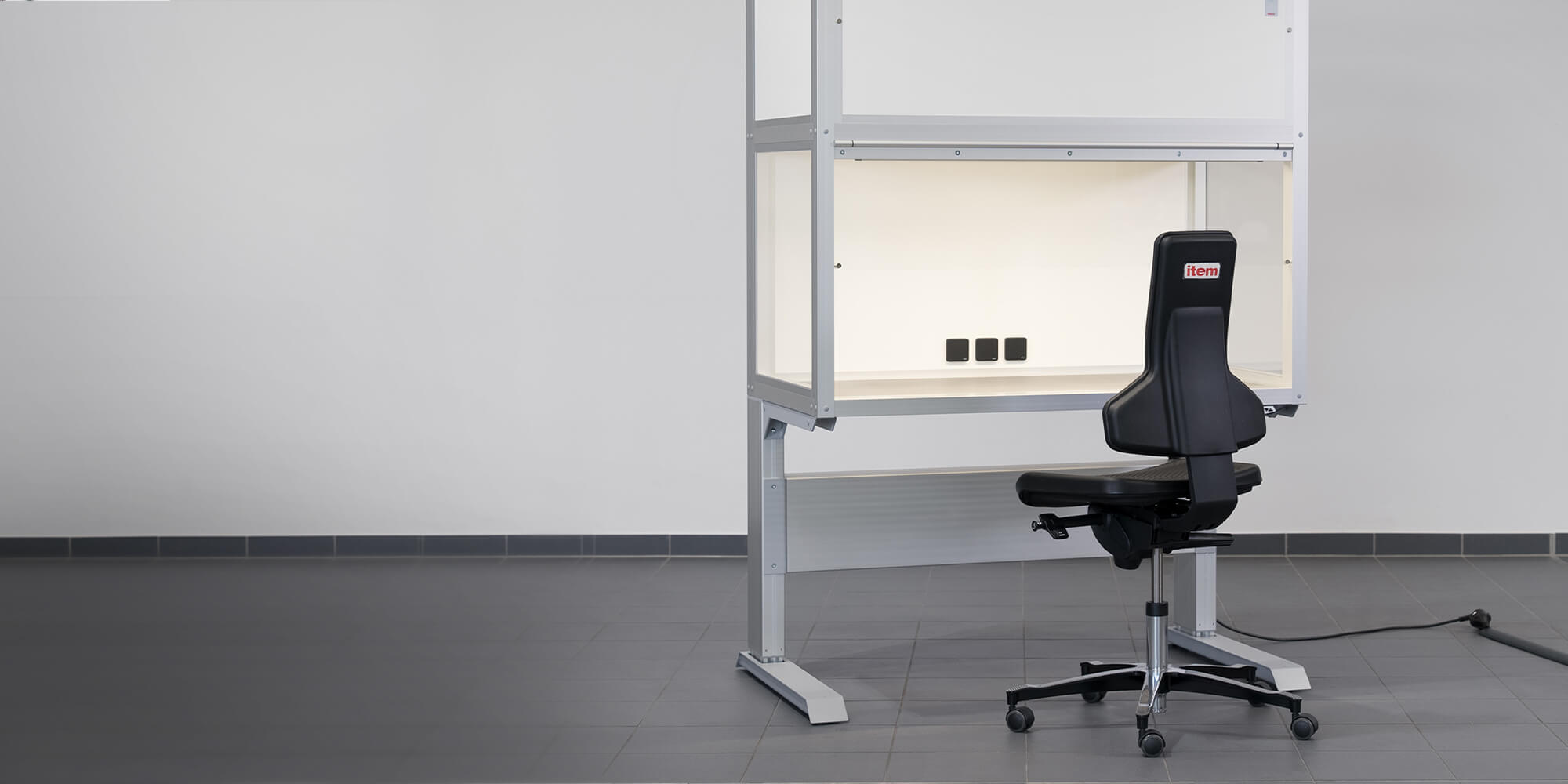In many industries, production needs to take place in a low-particle cleanroom environment. But what’s the best way of creating this environment?
“All materials and equipment inside a cleanroom, such as chairs, work benches and other objects, must meet the stringent requirements applicable to cleanrooms,” says Kevin Haas. As a product manager and cleanroom expert at item, he knows exactly what matters when it comes to cleanroom technology. It’s all about creating a low-particle environment. Cleanroom-compatible components from the item Building Kit System offer the perfect solution, as they have been specifically designed for this purpose. For example, you can use the modular Fixing System for flush surfaces to construct cleanroom-compatible walls and ceilings. The smooth, unbroken surfaces of the aluminium profiles offer two key advantages – they are easy to clean thoroughly and they also prevent particle deposits. Ergonomic work bench design also plays an important role in cleanrooms. Why? Because each and every unnecessary movement stirs up particles, so the fewer movements workers make, the better. Our modular building kit principle combines both aspects of cleanroom technology.

An overview of item solutions for cleanrooms
Whether you’re looking for specialist machine cabins with integrated filter fan units and air recirculation or work benches for clean production, you will find what you are looking for in the range of item products suitable for the manufacture of sensitive products in cleanrooms.
The challenges of cleanroom technology
Production in cleanrooms is subject to strict rules and regulations. You can find the general requirements for a cleanroom for technical applications in DIN EN ISO 14644-1. In this standard, particle concentration is categorised into nine cleanroom classes – ISO 1 to ISO 9. The lower the class, the more stringent the air cleanliness requirements are. For example, in ISO class 1, the maximum number of particles with a diameter greater than or equal to (≥) 0.1 µm permitted per cubic metre of air is just 10. In class 6, the equivalent figure is one million. The EU GMP guidelines define cleanroom classes (which it refers to as “grades”) for the food and pharmaceutical industries, and contain detailed information about preventing microbiological contamination. There are four different cleanroom grades for GMP risk analysis, namely grades A to D. Grade A requires the highest level of cleanliness for the manufacture of sterile products.
It’s really important to raise awareness of the right way to behave in cleanrooms. That’s a particular challenge on top of the technical aspects when implementing projects in a cleanroom environment.
There are two aspects that play a key role in cleanroom environments – cleanroom-compatible equipment and staff who are aware of the responsibilities involved. Haas knows what matters when it comes to cleanroom technology. “The number one priority is to prevent particle emissions and deposits. This means making every effort to avoid horizontal surfaces and prevent friction between components,” he explains. Staff need to comply with strict clothing regulations and follow set routines when putting these clothes on. These are not the only requirements they need to adhere to, however. Careful conduct also helps maintain a safe cleanroom environment, because abrupt, uncontrolled movements might lead to particles being stirred up unnecessarily. Regular training sessions make employees more aware of the risks in cleanrooms. “It’s really important to raise awareness of the right way to behave in cleanrooms. That’s a particular challenge on top of the technical aspects when implementing projects in a cleanroom environment,” Haas explains.
Solutions for small cleanrooms – how to create cleanroom-compatible work benches efficiently
When multi-stage processes are involved, the requirements in terms of the cleanroom class will often be different for each stage. These processes are often performed in large cleanrooms, which are usually designed in line with the requirements of the strictest class applicable to the process. Standard solutions are not an option. “Sensitive production environments sometimes include areas that must comply with even more stringent levels of cleanliness,“ explains Haas. The requirements vary depending on the industry, sector and product. For most cleanroom applications, ISO class 7 or 8 will suffice. However, setting up large cleanroom solutions is often very expensive, especially when you consider the complete service life of a cleanroom. There are other challenges, too. Space in the production environment is often limited, for example. Sometimes, it is only specific production areas that need to be fitted with cleanroom technology, so solutions based on our modular building kit principle offer you a space-saving, cost-effective alternative.
Separate, smaller cleanroom systems are often a more cost-effective alternative to large cleanrooms.
“Separate, smaller cleanroom systems are often a more cost-effective alternative to large cleanrooms. It’s essentially a case of creating a cleanroom within the cleanroom,” explains Haas. These solutions are also known as micro-environments. item can help you put a micro-environment together. For example, it might consist of a laminar flow box with Filter Fan Unit and a height-adjustable work bench. A filter fan unit draws air in, cleans it and generates a laminar air flow, thereby ensuring cleanliness in the process area. The clean air displaces particles that are present and reduces contamination to a minimum. At the same time, the air can be routed away through a perforated sheet. “With these mini-environments, we meet the requirements of ISO class 5,” Haas explains. You can use the item Building Kit System to implement a wide range of cleanroom applications, from individual work benches with a laminar flow box to partial enclosures and machine cabins. It’s also easy to adapt the shape, size and equipment of your cleanroom solution to suit a particular application. “For the quality control of lenses in camera production, for instance, it’s relatively easy to convert work benches inside a cleanroom to create a cleanroom workstation that complies with a more stringent ISO class,” Haas says.

Online training on cleanroom technology and cleanroom classes
Would you like to find out more about cleanrooms? The online training units “Introduction to cleanroom technology” and “Cleanroom technology regulations, focusing on ISO 14644” are available for free in the item Academy.
Working ergonomically in cleanrooms
In manual production, taking account of ergonomic principles is standard practice. Ergonomic work benches from item take the strain off staff and boost productivity. To date, we are the only supplier to have been given the “Certified & recommended” seal of approval from the Campaign for healthy backs (AGR). Height-adjustable work benches and chairs can be easily adjusted to suit each individual employee, thus offering optimal working conditions. Switching dynamically between sitting and standing is good for the entire body, while the ideal lighting has both physical and mental health benefits. Flexible tool storage and material supply help employees to work efficiently. You should pay even more attention to ergonomics in cleanrooms than in conventional production facilities, because the conditions in cleanroom environments are fundamentally more challenging. Cleanroom staff work in an environment with very dry air, for example, while their freedom of movement is restricted by the protective clothing they need to wear. From a visual perspective, cleanrooms usually feature just a small range of colours and tend to put strain on the eyes. This causes dips in concentration, which can quickly lead to mistakes being made. Ergonomics counteracts these effects and also helps keep the air clean – ergonomic measures in cleanrooms specifically prevent unnecessary air turbulence, because every manual process step is adapted to suit the individual worker, thereby optimising the movement involved.
After all, a perfectly designed working environment is also an expression of appreciation and therefore an important factor for employees, especially in the current climate.
A prime example of an application is our laminar flow box. With this cleanroom solution, you can take advantage of typical ergonomic principles. “The interior of the box can be equipped with pivot arms to supply materials and tools, and with other components from the item Work Bench System. It can be flexibly adapted to suit the needs of the employee and process alike,” explains Marius Geibel, who is a product manager and ergonomics expert at item. By using the item building kit principle as a basis for designing your modular cleanroom work benches, you can react quickly when employees and/or process conditions change. The large selection of cleanroom-compatible components gives you all the flexibility you need, and you can also factor in the various requirements for an ergonomic work bench design. This focus on ergonomics not only has a beneficial impact on health, productivity and air cleanliness, but also boosts employee loyalty. “After all, a perfectly designed working environment is also an expression of appreciation and therefore an important factor for employees, especially in the current climate,” Geibel emphasises. During these times of the war for talent – in other words, the competition to attract skilled workers – this factor is becoming ever more important.
How item makes production in cleanrooms ergonomic and safe
Employees should not be exposed to any unnecessary stress or strain – and this applies to cleanroom staff, too. So why not use our ergonomic cleanroom technology for your clean production solutions? By creating an ergonomic working environment, you will be looking after the health of your workforce. What’s more, you will be complying with the strict requirements applicable to cleanrooms, too. Thanks to the modular design, you can integrate small cleanrooms into existing structures with ease and efficiency – and allow the various benefits of the world of item to intermesh perfectly.
Want to keep up to date with everything that’s going on in the world of item? Simply subscribe to the item blog by completing the box at the top right.


